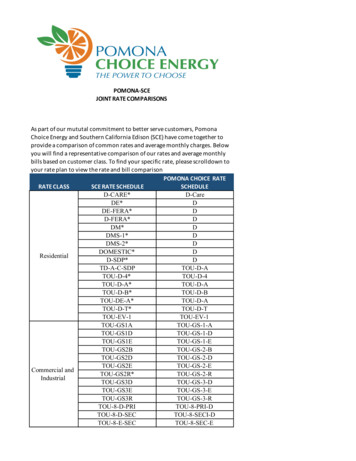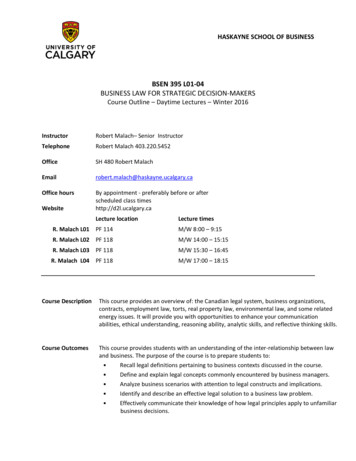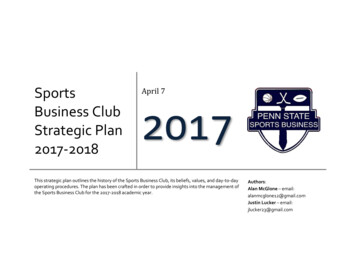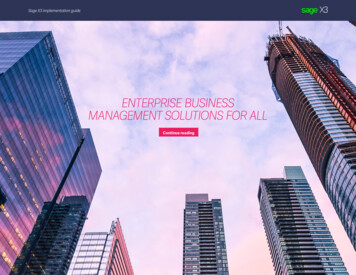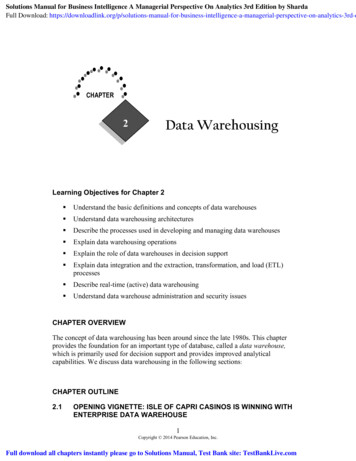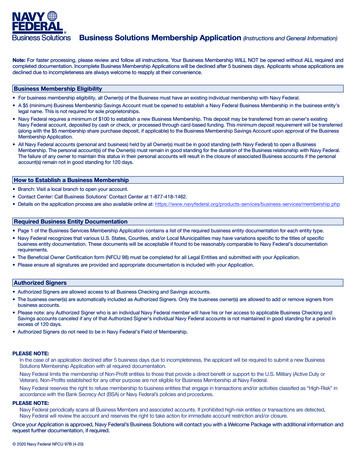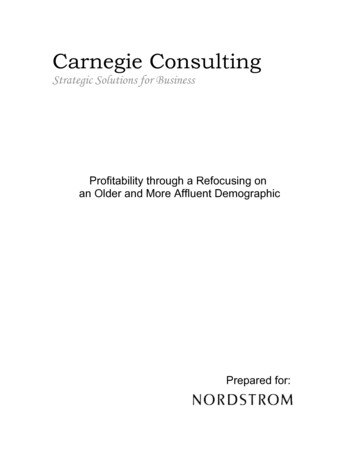
Transcription
Carnegie ConsultingStrategic Solutions for BusinessProfitability through a Refocusing onan Older and More Affluent DemographicPrepared for:
Table of ContentsExecutive Summary . 3Company History. 3Internal Rivalry. 4Substitutes and Complements. 5Entry. 6Buyer and Supplier Power. 6Strengths, Weaknesses, Opportunities and Threats. 7Financial Outlook . 10Strategic Analysis: . 13Carnegie Consulting425 North College Avenue s Claremont, CA 91711-2-
Executive SummaryNordstrom has a long established history of providing quality products and excellent customerservice. Like many of the upscale retail department stores catering to an older and moreaffluent consumer base, Nordstrom relies on its reputation to provide higher profit margins anda loyal customer base. The threat of entry into the market is significantly reduced due to therequisite branding for an entering company and the loyalty of existing customers. The buyerpower in the retail department store industry is limited because individual buyers rather thanfirms or conglomerations are the purchasers. Supplier power tends to be more significantsince department stores rely on a supplier’s brand to provide incentives for the consumer toshop at its store.Initially, Nordstrom’s focus and attention on the needs of its customers allowed it to expandand profit in the retail industry. Recently, its lack of customer attention has resulted inreduced profitability. In an effort to attract a younger consumer, Nordstrom altered its buyingstrategy and the overall ambiance of its stores. The fashions that attracted an older and moreaffluent consumer were replaced by styles targeted towards a younger and more “hip”demographic. Although this is not always a bad strategy, Nordstrom has failed to attract thetargeted demographic, resulting in large expenses associated with their inability to turn overinventory.Carnegie Consulting’s analysis of Nordstrom’s current market position and potential for futureprofitability leads us to the recommendation that Nordstrom refocus on the client base thatmade the firm successful. There are several reasons why for Nordstrom an older and moreaffluent demographic is superior to a younger and less affluent one. First, disposable incomesubstantially increases, which directly translates into an ability to purchase more expensiveitems. Second, older consumers tend to be more company loyal and more willing to invest inrelationships with a firm. Third, because consumers are more willing to invest in arelationship, customer service levels will increase because there is a larger financial incentivefor the sales team. Finally, this demographic already believes that Nordstrom was created forthem. They will eagerly return when Nordstrom turns its attention back to them.Refocusing on the traditional Nordstrom demographic will not be accomplished quickly, just asthe movement away was not immediate. Carnegie Consulting outlines a few initial steps thatshould be taken by Nordstrom to accomplish this task including (1) a marketing campaignfocused on attracting an older and wealthier demographic and (2) increased Nordstrom buyerawareness of the target demographic’s fashion requirements. Carnegie Consulting believesthat this refocus will allow Nordstrom to prosper in the future.Company HistoryIn 1901, John Nordstrom and Carl Wallin created Wallin & Nordstrom, a small shoe store indowntown Seattle. The philosophy of the company was to provide a large selection of qualityCarnegie Consulting425 North College Avenue s Claremont, CA 91711-3-
products with high levels of customer service. The success of the store led to the opening ofa second store in 1923.The retirement of John Nordstrom in 1928 brought the second generation of the Nordstromfamily into the business. A year later, Carl Wallin also retired and sold his shares to theNordstrom family. By 1960, Wallin & Nordstrom was the largest independent shoe chain inthe United States with eight stores in Washington and Oregon. The 1960’s also marked thefirm’s first foray into clothing apparel with the purchase of Best Apparel. A name changefollowed and customers began shopping at Nordstrom Best. The late 1960s also saw theappearance of both men’s and children’s clothing in the stores.The third generation of Nordstroms took charge of the company in 1968. The company wentpublic on July 29th 1971 at 24.50. Adjusted for stock splits the value was 0.5104. Twoyears after going public, Nordstrom Best passed 100 million dollars in sales and formallychanged its name to Nordstrom, Inc.In 1975, the first Nordstrom Rack opened in Seattle. The Rack opened as a clearance centerfor full-line store items, allowing for continual change in merchandise. Three years later,Nordstrom entered the California retail market, followed by store openings on the East Coastin 1988.Along with large scale expansion, the third generation of Nordstrom owners ushered in an illconceived new management philosophy. Nordstrom moved away from focusing on an olderand wealthier demographic towards a younger and less affluent one. The attention to storelevel details such as independent buyers was removed in favor of mass purchasing on anational level. Removing buying decisions from the local level reduced the ability ofNordstrom stores to efficiently cater to the unique needs of its clientele. In turn, this resultedin inventory that could not be sold increasing costs and reducing profit margins.In 2001, celebrating its 100th birthday, Nordstrom had 120 stores throughout the United Statesof which 77 were full-line, 38 were clearance, 2 were free-standing shoe stores and 3 wereFacconable boutiques purchased in 2000. Despite its strong growth, Nordstrom faces seriousfinancial problems. While revenues have grown by 91.2% over the past 11 years, expenseshave grown 97.5% equating to a 5.9% drop in earnings. Also the growth in revenues wasfueled by store expansion and not increases in same store sales, which were stagnant at anaverage of .94% growth.1Internal RivalryNordstrom is an upscale retail department store which competes with Neimen Marcus,Bloomingdales and Saks 5th Avenue, among others. Retail department stores sell men’s,women’s and children’s2 apparel along with shoes and accessories. The standard industrialclassification is 5651.1Nordstrom. 10 Year Statistical Summary. 2 April 2002 http://about.nordstrom.com/aboutus/investor/10yr stats.asp 2Many Nordstrom stores do not offer children’s clothing.Carnegie Consulting425 North College Avenue s Claremont, CA 91711-4-
The retail industry can be understood by examining two criteria: breadth of product line andvalue added. Nordstrom carries a large variety of products and has a high level of customerservice, ambiance and brand image. Because of it’s positioning, Nordstrom does not competeon prices but rather on factors like service and quality (i.e. higher value added). The highlevel of “extras” provided by such department stores results in higher margins and lowervolumes. Department stores like Bloomingdales and Saks 5th Avenue also have similarpositioning in the market.The other side of the department store spectrum stands stores like Macy’s and JC Penney.They offer a wide variety of products but compete largely on price. The value added to theshopping experience (e.g. piano player in the lobby, uncluttered clothing selection and overallstore appearance) is low, relying more on higher volume sales to offset lower margins.Substitutes and ComplementsSubstitutes can constitute a threat to the industry, decreasing its customer base and providingsome price competition. The main substitutes are niche retail stores, online retail sites,discount stores and mail order retailers. Niche retail stores, such as Banana Republic andArmani Exchange, provide similar apparel to that offered in a department store, though theycommonly offer a narrower range of choice. Sometimes the products are identical, such asmany products in Ralph Lauren stores, so competition is largely focused on convenience andselection. Other niche stores, such as Banana Republic, provide different brands thatcompete directly with the products carried by department stores. These niche competitors donot compete directly with retail department stores. They instead pose a flanking threat byoffering a more limited and specialized set of goods. By specializing in a specific category ofcustomers or goods, they can provide a focused experience and lower prices than upscaleretail department stores that attempt to focus on a wide range of goods and customers.The recent proliferation of online retail sites, such as Bluefly.com, has placed additional pricepressure on the department store industry. Online retail sites offer discount prices on goodsthat are often identical to those in a department store. They cater to customers who areconcerned about brand and quality, but prefer price over service. Customers sometimes usethe retail department stores and their services to experiment with goods they intend topurchase online. This increases the costs for department stores while depriving them ofrevenue. As high-end customers become more accustomed to the Internet, particularly topurchasing goods online, the threat of online retail to upscale retail department stores willgrow.Mail order retailers like Lands’ End share many of the characteristics of online retailers.Because they lack a significant “brick and mortar” presence, they too have the ability to bemore price competitive than department stores. They also realize efficiency gains in inventorymanagement since the number of distribution points tends to be limited. As mail orderretailers have become more accepted and have established brand images, they haveencroached upon the traditional consumer base of high end retail department stores.The financial success of department stores is often related to the health of complementaryindustries, such as malls. Upscale department stores serve as “anchors” because they canattract consumers. Nordstrom has been particularly successful playing this role. AnchorsCarnegie Consulting425 North College Avenue s Claremont, CA 91711-5-
receive rent reductions as an inducement for them to locate at specific malls. The profitabilityof such stores is correlated with the financial health of their mall, with popular malls generatingadditional foot traffic due to shopping externalities and correspondingly higher sales at theiranchor stores.Upscale department stores are also affected by the strength of upscale job markets, withmany of their customers buying clothes for work in industries such as law and banking.Strong growth in high-income employment fuels demand for the goods and services in whichupscale department stores specialize. This growth in demand is focused on work attire, butalso spills into other departments because customers often decide to buy additional apparelonce they are in the stores. A societal move toward casual dress in the workplace has notbeen good for Nordstrom.EntryThe major threat of entry into the upscale retail department store market comes fromestablished niche firms expanding their selection and stealing a portion of the consumer base.There are significant advantages to this approach over a direct entry into the department storeindustry through opening a completely new department store. The supply chain is alreadyestablished along with a brand name and customer base. Also, the entry can beaccomplished gradually with incremental expansion of the product line.Buyer and Supplier PowerBuyer PowerBuyer power in the industry is limited due to the size of individual purchases. Theoverwhelming customer base of the retail department store is the end consumer and not largevolume buyers. This results in the inability of the buyer to extract profits from the seller.There are certain factors that increase buyer power. The geographic proximity of manydepartment stores and publishing of prices online allows consumers to shop efficiently. Also,proximity of competitors reduces the switching cost for consumers while aggregating shoppersinto a single location.Supplier PowerSuppliers in the retail department store industry tend to have substantial power. Land andbuildings are a major component of retail cost and their scarcity in places of high populationdensity allows the supplier to extract a significant portion of the retailer surplus. Developers ofretail sites are also able to capture most of the site rents that come from the externalities ofagglomeration previously discussed. Nordstrom, as an anchor store, however, is also able tocapture a part of these site rents as well.The ability of clothing suppliers to extract profits from the buyer is based on their brand’sability to attract consumers. Designers who create successful branding can charge higherCarnegie Consulting425 North College Avenue s Claremont, CA 91711-6-
prices than companies who’s products are essentially commodities. This is especiallysignificant for a store like Nordstrom that cater to a high end, brand conscious clientele.Strengths, Weaknesses, Opportunities and ThreatsStrengthsCustomer Loyalty and SatisfactionCustomer loyalty and satisfaction are closely intertwined. The most recent figures released inthe American Customer Satisfaction Index (ACSI) show that Nordstrom is highly competitivewith other department stores in customer satisfaction, receiving a rating of 76. Nordstrom’srating is higher than competitors such as May Company and Federated Department Stores.Employees of Nordstrom interviewed by Carnegie Consulting believe that customersatisfaction is one of the company’s most important attributes. Indeed, they largely creditNordstrom’s care and attentiveness as the reason for customers choosing it over less costlyalternatives. Specifically, Nordstrom employs personnel and establishes company policiesthat are very customer-friendly. For example, Nordstrom allows customers to return productsregardless of the purchase date. During many visits employees were extraordinarily helpful,for example offering to teach one shopper how to tie a bow tie (a timely process).Customer loyalty is the payoff for such amenable customer service and company policies.Although no specific data were available to confirm their assertion, employees and managerstold Carnegie Consulting that the vast majority of Nordstrom’s customers are repeatcustomers. They are loyal to Nordstrom because no other store satisfies their needs as wellas Nordstrom. It bears emphasizing that customer loyalty is generated because no storesmeet customer needs “as well,” not “as cheaply.” Nordstrom customer loyalty is not the resultof low prices, but of better service.Serving an Important NicheNordstrom is not merely another department store whose wide product offerings make it a“store for everyone.” Rather, it is differentiated from its competitors as an upscale shoppingplace for upper-middle to upper-class and late twenties to mid-sixties consumers. Its productselection, employee training, and overall focus position Nordstrom to serve this section of themarketplace better than others. Nordstrom caters to customers who shop at Nordstrom forthe product and service quality, rather than price.Although most of Nordstrom’s client base consists of people from the aforementioneddemographic strata, Nordstrom also has departments that appeal to a younger clientele, suchas The Rail and Brass Plum, and this expands Nordstrom’s customer base. In addition tocreating sales, these departments help diversify Nordstrom economically, groom newcustomers and ensure that all customers’ needs are being met.Carnegie Consulting425 North College Avenue s Claremont, CA 91711-7-
WeaknessesInventory ManagementNordstrom’s managers and floor associates are well aware of its serious deficiency ininventory management, which the company has only recently taken steps to remedy.Inventory management issues are perilous for two reasons: First, they create higher costs andlower margins. The operating margin for Nordstrom over the last five years is 5.59%, which isover four percentage points below the industry average.Second, and more important for Nordstrom, poor inventory management prevents goods fromreaching customers in a timely manner. Anecdotal evidence is abundant. One men’sdepartment manager explained that the jeans were counted by hand and reordered everyMonday. If one size of jeans sold out on Tuesday the sold-out size would not be re-ordereduntil the following Monday, and so would not arrive and be placed on the shelves for anotherweek after that. Thus, customers who want a specific item that is not in-store cannot expectthe item to be replenished into the Nordstrom inventory in a timely fashion.New inventory control measures are being instituted across most Nordstrom stores.According to one store manager, preliminary results show that the new system is much moreefficient, lowering costs and allowing Nordstrom to serve its customers better. The success ofthe new inventory control system, however, will depend on how well management andassociates are trained to use the system.Fashion MistakesNordstrom’s inability to purchase items attractive to either its traditional or its newly targetedyoung clientele is a significant failure resulting in decreases to its profit margins and thealienation its consumers. The inventory turnover rate is 3.55 for Nordstrom compared to anindustry average of 4.78. The ratio implies that Nordstrom is not providing a product selectionattractive to its customers. This results in additional cost of managing and storing theunwanted inventory, along with further decreasing margins due to the necessity of reducingprices in an effort to sell the goods. In addition, consumers, unable to find the desiredproducts, will patronize other department stores eroding Nordstrom’s market share.Exposure to Business CycleBecause of Nordstrom’s specific clientele base and its competition on service rather than onprice, Nordstrom is especially vulnerable to fluctuations in the business cycle. In the followinggraph, note how Nordstrom (ticker symbol: JWN) follows the trend of the Dow, but greatlyamplified.Carnegie Consulting425 North College Avenue s Claremont, CA 91711-8-
Investors are aware that Nordstrom sales are sensitive to economic fluctuations, which in turnadversely affects its stock price.OpportunitiesIncrease Market Share through ExpansionNordstrom is currently increasing its base of store locations under its three most popularbrands. Nordstrom’s capital expenditure has grown an average of 4.92% over the last fiveyears while its counterparts in the industry have decreased theirs by 9.10%. The Northeast,Southeast and parts of the Midwest are still largely untapped markets available for Nordstrom.There are also expansion possibilities overseas through the Facconable boutiques. There aredangers associated with expansion and are discussed in the following section.ThreatsLoss of FocusRecent managerial decisions to fire local buyers and to centralize fashion decisions andpurchasing are contributing to a diminution in the company’s effectiveness and to deteriorationin Nordstrom’s market share. Customers historically preferred Nordstrom, not only because ofits outstanding customer servic
Nordstrom entered the California retail market, followed by store openings on the East Coast . The main substitutes are niche retail stores, online retail sites, discount stores and mail order retailers. Niche retail stores, such as Banana Republic and . many of their customers buying clothes for wor
